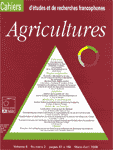Évaluation du pouvoir fertilisant de deux légumineuses spontanées comme source d'azote dans les systèmes de culture de maïs au Congo
Résumé
Field trials conducted at the Institut de Développement Rural (Brazzaville, Congo) revealed the nodulation of Crotalaria juncea and Mucuna pruriens by native soil rhizobia. C. juncea produced a mean of 98 nodules per plant, while M. pruriens produced a mean of 32 nodules. Nodule masses of the two legume species were 89 mg/plant and 306 mg/plant, respectively, for C. juncea and M. pruriens. The crop accumulated a mean of 227 kg N/ha and 108 kg N/ha for M. pruriens and C. juncea, respectively. The efficiency of using M. pruriens as green manure for the succeeding maize crop was equivalent to applying 88 kg N/ha, while that of C. juncea was equivalent to 76 kg N/ha). The experimental results illustrated the nitrogen fixation potential of the two legume species and their beneficial effects on subsequent maize crops in the Congo.Téléchargements
Publié
1999-03-01
Comment citer
Mandimba, G. R. . (1999). Évaluation du pouvoir fertilisant de deux légumineuses spontanées comme source d’azote dans les systèmes de culture de maïs au Congo. Cahiers Agricultures, 8(2), 129–131 (1). Consulté à l’adresse https://revues.cirad.fr/index.php/cahiers-agricultures/article/view/30161
Numéro
Rubrique
Articles

